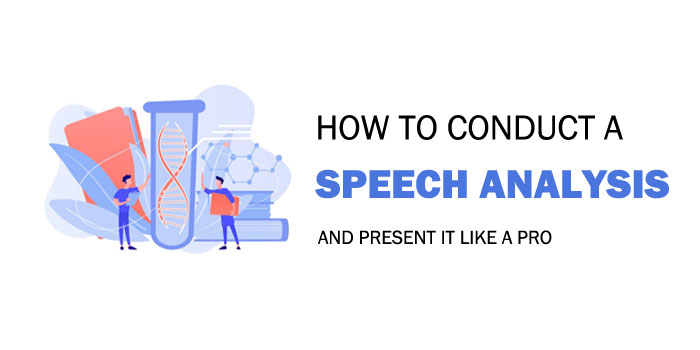How to Conduct a Speech Analysis and Present It Like a Pro
Who doesn't dream of delivering the perfect speech? Every person who speaks in front of a crowd wants to leave them moved. However, not everyone can do that.
Even the greatest speakers have worked for years to master the art of public speaking. Although we may not know their secret, we can learn a lot from their work. That's where speech analysis helps. Let's find out what it is and how to benefit from it.
What Is Speech Analysis?
You probably know the standard definition already – it is a process of studying a speech's good, bad, and pain points. However, what does it have to offer to you?
In essence, speech analysis means understanding the useful information in the speech and setting it aside from what isn't handy. For instance, a renowned speaker comes on stage to deliver a speech, and you have to perform a speech analysis – what will you look for?
You will observe the speaker's gestures, body language, confidence, usage of terms, sentence structure, quality of speech, proper delivery of the message, and much more.
This plethora of factors contributes to a single word called speech analysis. Now that you know what it is, let's have a comprehensive look into these factors.
How Does Speech Analysis Work?
For analyzing a speech, the first thing you need is information.
You need to know the perfect way to begin the speech, convey the message and give an immediate call to action.
You also must identify where the speaker is wrong and what was lacking in the speech.
For instance, if the targeted audience is teenagers, you should be able to tell if the humor and jokes used were appropriate. Was the speech engaging or lackluster? Did the audience understand the message?
Let's see what these aspects entail below.
Introduction of the Speech Analysis
First thing's first, add an introduction. It usually begins with a hook, something to entice the reader. Then it mentions the time and place of the speech, followed by an overview of the address.
Next, you need to mention the speaker, the topic, and the key points of the speech.
Body of the Analysis
Once done with the analysis, you need to begin crafting the body. This includes some special and some general details of the content and delivery, and writing them in a critique manner.
Usually, this begins with a certain action of the speaker, like tone, gesture, or emotion.
The description of some of the common factors is given below.
Identify the Objective of Speech
The purpose plays the most important part here as it is the deciding factor of the nature of the speech.
Is it an entertainment speech with a few jokes and funny lines here and there or an educational speech delivering quality information?
Was it a script written to motivate the audience for a bigger cause? Was it delivered in a manner to promote a product among the audience?

What is the message being conveyed? If it promotes peace and equality and focuses on making the world a better place, your analysis should consider that.
Similarly, identify if the person delivering the speech is the right person for the job. He must deliver the speech perfectly or at least achieve the purpose set.
Once you get your head around these points, making an analysis becomes easy.
Be Mindful of the Target Audience
A good speaker knows that a speaking style used for 50 cannot be used for 2000 people. Similarly, the tone or technique used with business leaders cannot be used with homemakers.
You need to see how well the topic resonates with the audience and how engaged they are.
Say a spokesperson delivers a speech about leading SEO strategies in 2022. The audience will comprise people familiar with digital marketing or those who want to learn it.
It will include related terms, anecdotes, stories, facts, and stats that will bind the audience to the topic.
For the speech analysis, you must also consider if the speech is being broadcasted to an external audience on streaming platforms.
Bring in the Juicy Part: Content of the Speech
The heading says it all.
We cannot stress enough. The content of the speech is by far the most vital part of the script. It can make or break the overall mood.
The Opening: Pay special attention to the opening of the speech. Usually, a hook, controversial statement, or question is used to garner the audience's attention.
An interactive, intuitive opening is much preferred to a dry opening, saying, "Hello everyone, thank you for having me."
The Main Body: Once you write all this down, move on to the body of the content. You need to deduce if the topic was authoritative. Did it include a particular focus on the subject matter? Did it have stories and facts that connected back to the issue?
How did the speaker transition from point to point?
Speech analysis also requires you to check if statistics or visuals were used to support the arguments. It is better to use graphics to convey the message better, and you need to study if they did the work. You must analyze how well the speech was constructed and organized efficiently.
The Ending Words: Lastly, determine how valuable, memorable, and well defined the ending of the speech was.
Was it concise? Did the review do justice to the speech? Did it list the good and bad parts of the speech? These points will make up for a strong conclusion influencing the reader's mind that you have a strong hold on the subject here.

These were the main three points of speech content; the opening, body, and conclusion. This is an easy approach to follow and can help you with speech analysis quickly.
Observe Style and Delivery Manner
In scripting and speaking, the delivery style and techniques are the best tools, provided you know when and how to use them.
When analyzing a speech, you must view the speech from a critic's perspective. Observe the mood and vibe of the audience during the speech.
Were people bored or engaged? Was the session interactive? Did it teach you something you didn't know?
These questions will tell you the experience of the audience. Try putting yourself in the audience's shoes, and you will understand how useful it was for them.

Next, observe the speaker.
Was he nervous? Did he know what he was saying? Often at such times, the body language communicates the confidence of the speaker.
You may also notice the stage area used by the speaker. Did he pace around the stage or stand in one place? All these factors determine the speaker's delivery style and make a significant portion of the analysis.
Determine Correct Usage of Visuals
Yet another critical factor of speech analysis; determining the proper use of visuals. This adds so much life and energy to the speech. The experience becomes more realistic.
According to research, more than 67% of people feel more inclined and engaged in speeches that include visuals.
This is generally true too. An average person would enjoy a speech with infographics, charts, images, short clips, and figures rather than a dull, verbal presentation.

You need to see if the speaker used sufficient visual aids and whether they were succinct in delivering the message.
Did the visuals complement the speech? Were they fun and easy to understand? Did the audience like and engage with them?
Observing these during the speech will make the analysis quick and condensed.
Consider Language and Choice of Words
Since language and words are the modes of communication for the speaker here, it is essential to know how he uses them.
Say the topic is about the best places to buy Bitcoin. You now need to see if the speaker uses the proper terms to address the topic.
Does he explain the concept of Crypto and how it works? Does he tell how Bitcoin reached fame and all its background?
That makes for the comprehensiveness of the topic.

Next, inspect the use of language. Is it appropriate for the audience? Does it use slang words, or is it too bland? Are the terms difficult to understand?
A fine point to make in your speech analysis would be the flow of the speech. In this, you can mention how fast or slow the speaker was.
His articulation of words, the length of sentences, and their ease of understanding. You can also mention the uniqueness or repetitiveness of words, sentences, ideas, or rhetorical devices in the speech.
The only way you can do justice to a speech analysis is by mentioning every good and bad point of the speaker.
Sound Experience
You might wonder why this is important – truth be told, this is an essential factor in crafting a speech analysis. How you hear something tells your mind how to perceive it.
For example, you purchase an online course.
As soon as you hear the tutor's voice, you feel annoyed and request a refund. Why?
Because the first thing your brain captured was the voice of the video playing in your mind, it might have been too sharp, distorted, or garbled for you to hear.
The same is the case with a speech; what you hear and how you hear influence your willingness to listen to the script.

So, you must include how well the speakers worked in your speech analysis. The pitch of the sound, how easy it was to hear and discern the words of the speaker.
This section in the analysis could also use the speaking pace of the reader. Additionally, talk about how the speaker paused after regular intervals to create suspense, arouse excitement, express grief, make a remark or add value to his words.
Gestures
You will feel special if someone looks you in the eye while you speak – so does the audience. Being a critic and speech analyst, you must observe how the speaker makes eye contact with the audience.
Does he shy away? Does he smile while making direct contact? Or does he keep looking elsewhere, avoiding the audience?
Adding all these points to your analysis will give it leverage over the others.
Gestures also include the movements and timings of the speaker. Did he use his hand to add energy and influence to his words? Were the gestures natural or forced? Were they distracting?
This part won't take up as much space or information but can help identify the right person.
Conclusion of the Speech Analysis
The conclusion is the final part of the analysis, where you summarize the speech and write an ending note.
Say you heard a speech about a woman who lost her husband to the DEA agents. She told with extreme pain and grief how they encountered him and shot him at point blank.
Now here's how you can write its conclusion:
"Samantha's speech engulfed me and the entire audience the moment she began her story. It hooked me, and I could feel her pain moving like waves in the hall and the audience.
However, I believe that the tone and pace should have been slightly lighter for my liking. Otherwise, the unfortunate incident with her husband didn’t allow her to control her emotions."
This will be your judgment and remarks that you acquired throughout the speech analysis. That makes up for a satisfactory conclusion to your speech analysis.
Final Verdict
You might find it challenging to analyze a speech at first, but once you learn the pain points, it's a child's game. Use the above factors to analyze your next speech and get an A+ on that assignment.
A good speech analysis manifests the intent, the audience, the content, the delivery style, visuals, and much more. Now that you know how speech analysis works, you're well versed with all the points.
That brings us to the end of this post. Happy Speaking!
